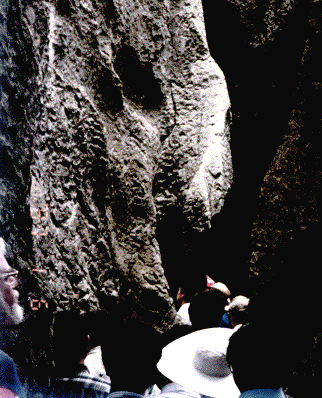

where:
The Forward Direction is to the right as you view this page. The Reverse Direction is to the left.
A System will be defined as some portion of the universe that you are interested. Everything else is part of the surroundings. The system and the surroundings are separated by a "boundary". Equation [1], for example could be a system.
Imagine the following experiment. A sealed bottle is half full of water. Gaseous CO2 from the air dissolves in the water and dissolved CO2 in the water escapes into the air.
CO2 dissolved in water / CO2 in the air
is constant at a constant temperature - the so-called equilibrium constant.
Chemical equilibrium is dynamic. If we disturb equilibrium by increasing the amount of CO2 in the air the reaction [2] adjusts by "reversing" the nature of the disturbance - that is, the amount of CO2 in the air is reduced by dissolving some of the "excess" in water. That is, in reaction [2] the Forward Direction is favored. The reaction continues until the balance between CO2 in the air and CO2 dissolved in water is that given by equation [3].
Imagine that this system is at equilibrium. Any process that increases the amount of CO2:
Therefore, when CO2 increases calcite goes into solution - dissolves.
The reverse is also true. Any process that reduces the amount of CO2 in the system will cause calcite to precipitate.
Temperature
Calcium carbonate, for example, is often found precipitating in proximity to hot springs.
In contrast, carbon dioxide is more soluble in cold water than in warm. In the deep ocean basins (water depths greater than about 11,000 meters), equation [2] is shifted so as to produce more carbonic acid which results in a shift to the right in equation [1] resulting in the solution of calcite. Calcite is not found in sediments in the deep marine environment.
The measure usually adopted for the acidity of a solution is pH:
Let H+ = 10-10 (units of moles per liter)
A logarithm is an exponent. In this case the exponent is -10.
Therefore, pH = - (-10) or 10.
As pH decreases, the amount of the hydrogen ion increases. Thus, low pH values are acidic and high pH values are basic. The world's oceans have a pH of about 8 - a weak base. Rainfall has a pH of about 6 - a weak acid.
In general, carbonates go into solution in an acid solution and precipitate in a basic solution. From equation [2], an increase in the acidity of the solution causes the system to shift to the right and calcite dissolves.